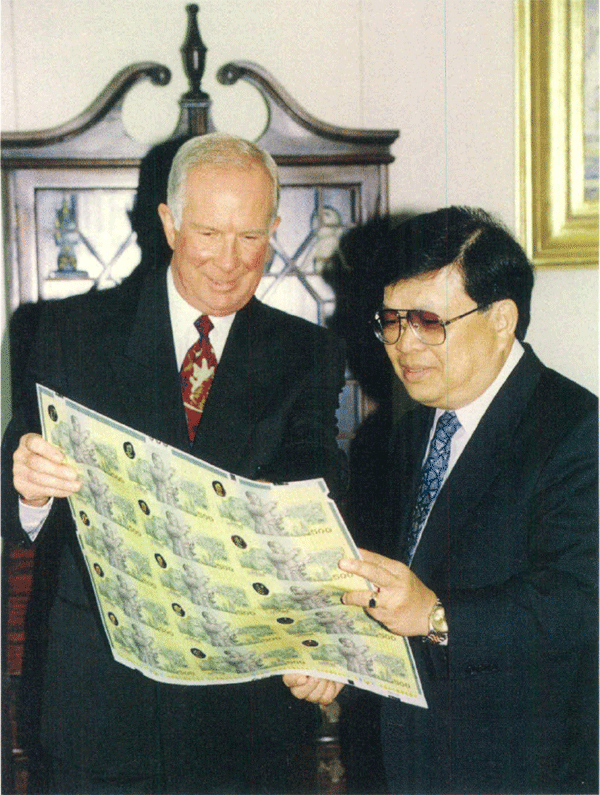Reserve Bank of Australia Annual Report – 1997 Note Printing
The printing of Australia's currency notes is carried out by an autonomous division of the Bank called Note Printing Australia (NPA), which is based at Craigieburn in Victoria. NPA is overseen by a Board, the Chairman of which is GJ Thompson, Deputy Governor. The other members are FM Bethwaite, Managing Director of RGC Limited, RFE Warburton, a non-executive member of the Reserve Bank Board and RL Larkin, Managing Director of NPA. This Board reports regularly to the Bank Board.
In conjunction with the Bank's Note Issue Department, NPA has pioneered the use of polymer for notes, as an alternative to the traditional paper. When Australia's new note series was completed, with the issue of the $100 note in 1996, it became the first country in the world to have all notes printed on polymer. NPA is, to date, the world's only manufacturer of circulating polymer notes.
Polymer notes have demonstrated significant advantages over paper in both security and durability. As an example, Australia's paper $5 note had an average life in circulation of six months; by contrast, its polymer successor first issued in 1992 is lasting at least two years. One result of this greater durability has been a steady decline in the required annual production of Australian notes. This has, in turn, freed capacity at NPA for other opportunities.
Consequently, the enterprise has been working to develop an export market for polymer notes for some time and has made notable progress in recent years. In addition to printing 195 million Australian notes in 1996/97, NPA produced 132 million notes for other countries, up from 50 million in the previous year. The major component was an order for Thailand, but notes were also produced for Brunei, Papua New Guinea and Western Samoa. For 1997/98 to date, NPA has secured export orders for Thailand and Sri Lanka. It is discussing the issue of polymer notes with several other countries. In March 1997 the one billionth polymer note was delivered off the presses. Of this total, approximately 14 per cent have been for export.
NPA markets a number of related technologies and, during the year, fulfilled a contract with a major overseas country for the supply of a high-level authentication system for the validation of notes returned from circulation. It is likely that further export sales will follow. NPA also operates a profitable numismatic business on behalf of the Bank.
In recognition of its overseas success, NPA won the Export category in the Prime Minister's Inaugural Awards for Innovation in the Public Sector.
Notwithstanding the inherent advantages of polymer, and its current leading position in this technology, the Bank believes that NPA will have long-term success as an exporter only if it becomes more efficient and commercially oriented. In pursuit of this objective, NPA has put much effort into refining and upgrading its management and quality assurance systems. Its progress in this was recognised in June 1997 by the award of ISO 9001 certification. NPA is also working to reduce its costs and increase productivity. Management has commenced a program to outsource non-core activities, where this is the more cost-effective option. It is also looking at opportunities to automate further NPA's processes and has a substantial capital investment program to modernise the facility. A new enterprise bargaining agreement is currently under negotiation with NPA's unions and a streamlined management structure is being instituted.

In June 1997, NPA employed 267 staff, compared with 552 ten years ago. Numbers will decline to near 200 in the latter part of 1997.
In May 1997 NPA's workers' compensation insurers, Comcare Australia, conducted an audit of NPA's occupational health and safety management system. The report congratulated NPA on its commitment and achievements, and suggested that the organisation was an excellent example to other Commonwealth agencies of the successful implementation of a risk management approach to health and safety in the workplace.

Early in 1996 the Bank, through NPA, formed a joint venture company with UCB Films PLC, a Belgium-based manufacturer of polypropylene films, to market and supply specialised polymer substrate to countries which have their own printing plants. The joint venture company, Securency Pty Ltd, is now well-established and has made contact with many potential customers. It has organised machine trials of polymer substrate with a substantial number of printers around the world. Securency has its head office in Australia and is also represented in Europe.
NPA and UCB are also working, together with the Bank's Note Issue Department, on an extensive program of research and development, with the aim of further improving the security and handling properties of polymer notes. Significant progress has been made on some highly innovative security features.
UCB has purchased land from the Reserve Bank adjacent to NPA's printing works for a manufacturing plant. This will produce specialised polymer film for use in note printing, as well as manufacture other UCB products for export to Asia.